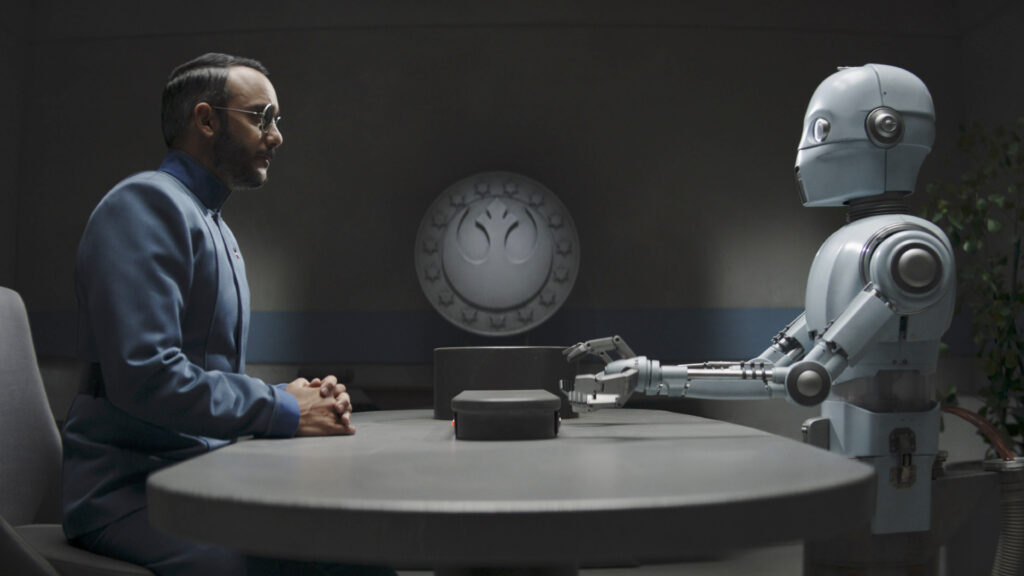The Mandalorian Season 3 Review: Chapter 19
Written by Ian Thomas Malone, Posted in Blog, Star Wars, TV Reviews
As a show, The Mandalorian is going through a television equivalent of puberty these days. What started as an episodic space western with an adorable breakout character is starting to embrace the idea of having an actual supporting cast, no longer content to treat Din Djarin as a Man with No Name-type stand-in. Whether a pivot toward serialization is a good idea remains to be seen, but Chapter 19, “The Convert” didn’t exactly present the best case for less Grogu in a world where many are perfectly fine with “The Baby Yoda Show.”
The episode started off with a bit of an unfortunate whiff. Mando takes his bath, completing his redemption arc without getting eaten by the Mythosaur, a win for any of us who were worried that the show might spend its entire season centered around helmet drama. Rather than build on actual narrative stakes between Mando and his reunited son, or Bo-Katan, the show throws us into a very rushed space battle with terrible CGI, unfunny R5-D4 antics, and plenty of plot holes. One could accept that Katan’s ship’s radars might not pick up a bunch of Tie Interceptors, but fans have known since the very first Star Wars that Ties can’t fly far without a carrier. The idea that Katan’s home is being bombed by a squadron with seemingly no warning or explanation for how they got there is clownish behavior for a franchise that does little else besides lean on nostalgia, the kind of stuff that can’t be covered up by Grogu rapidly opening and closing his pram, which isn’t as cute as anyone making the show thinks it is.
One can kind of see the logic in exploring a character like Dr. Pershing, who helped set up Team Mando’s Grogu rescue in the season two finale. Dedicating the majority of the longest episode of the series thus far to a tertiary villain is a tall order before anyone considers the Andor-sized elephant in the room. Right in the middle of The Mandalorian’s broader narrative identity crisis, the show made the inexplicable decision to start riffing off the only Star Wars show that could legitimately call itself a serious drama.
Andor is the only live-action Star Wars show that doesn’t deploy StageCraft, technology that’s often ruined The Book of Boba Fett, Obi-Wan Kenobi, and too many recent Marvel movies. While The Mandalorian is often one of the only Disney products to properly wield StageCraft, Andor, with its lavish practical sets, is one of the most beautiful shows on television. There is no world in which The Mandalorian’s Coruscant looks better than Andor’s. It’s unclear why the former even tried. Putting aside the differences in practical effects vs. StageCraft, it makes no sense for a series fresh off a two-plus year hiatus would bench its leads only to deliver its audience a cheaper version of a show many of them had undoubtedly recently seen.
The Mandalorian and Andor serve two very different audiences. The latter carries substantive, serious stakes, obviously intended for adults. The former is the standard bearer for an entire streaming service, a glorified live action cartoon. That’s not a bad thing either. Diversity of content is supposed to be a good thing, even if this episode reminded us that apparently Coruscant has “one trillion” permanent residents, even if the same handful of people keep showing up across this galaxy that can’t help feeling small as a result. This plotline had no business being in The Mandalorian, except maybe because The Mandalorian doesn’t know how to be The Mandalorian right now.
Some of this awkward Coruscant dynamic might have been averted if Dr. Pershing’s adventures with Elia Kane, who fans might justifiably mistake for a new character given how long it’s been since season two, had been broken up with a scene or two with Mando and friends in the middle of the episode. The end revelation sort of justifies this, as it might looked awkward for Katan to have a dialogue-heavy scene without removing her helmet, but the show didn’t exactly look great spending all that time on two characters plenty would have forgotten about. The sympathy the show wants its audience to feel for Pershing is totally undercut by the ease with which he instantly slipped back into his old cloning ways, a former villain violating the terms of his amnesty for seemingly no reason other than he thinks he knows better than people who didn’t try and perform lab experiments on the cutest character in television.
The episode almost redeemed itself at the end when Mando and Bo arrived at the Mandalorian hideout. There is clearly a darksaber-sized conflict brewing between the two, Bo keeping the mythosaur sighting to herself. Putting aside the silliness of the living waters of Mandalore, Vizsla delivered a compelling sequence on the nature of identity when she accepted Katan into their tribe, despite the latter belonging to a completely different sect of Mandalorian lore. Katan, who once sought the darksaber to lead her people to salvation, suddenly falls backwards into the same kind of found family dynamic she’s clearly been longing for during all of her throne sulks. As confusing as the rival Mandalorian factions are, and as clunky as the show dumps its exposition, this episode concludes with real narrative stakes established between two of its best characters, though the show may not be well-served by keeping Katee Sackoff under her helmet for too long.
Chapter 19 was an unfortunate dud that ended on a compelling note. The show started to take baby steps toward the plotline that consumed much its first two seasons, the value of Grogu’s DNA, but perhaps at the wrong moment. We don’t need a Dr. Pershing-centered episode before The Mandalorian has actually taken a moment to evaluate the nature of the relationship between Mando and Grogu, the latter of which will undoubtedly stick out like a sore thumb the longer his dad hangs out with his helmet clan. We certainly don’t need bargain bin Andor with StageCraft effects. We’re almost halfway through the season and things only start to feel like they’re headed in a cohesive direction.












